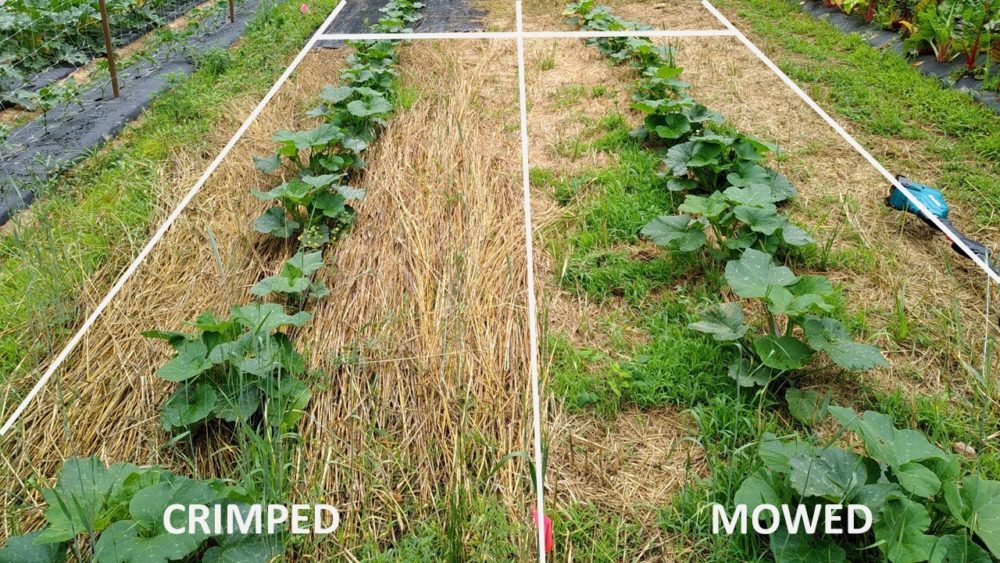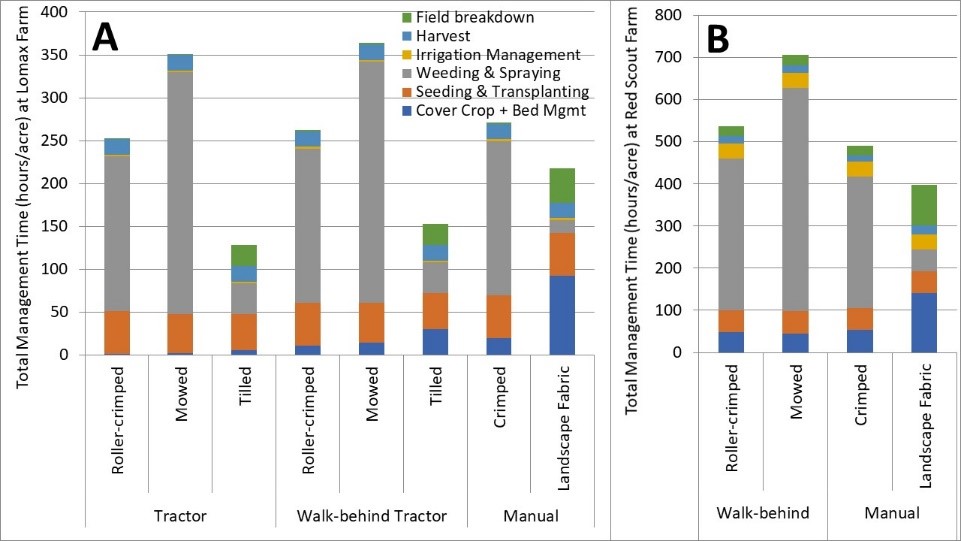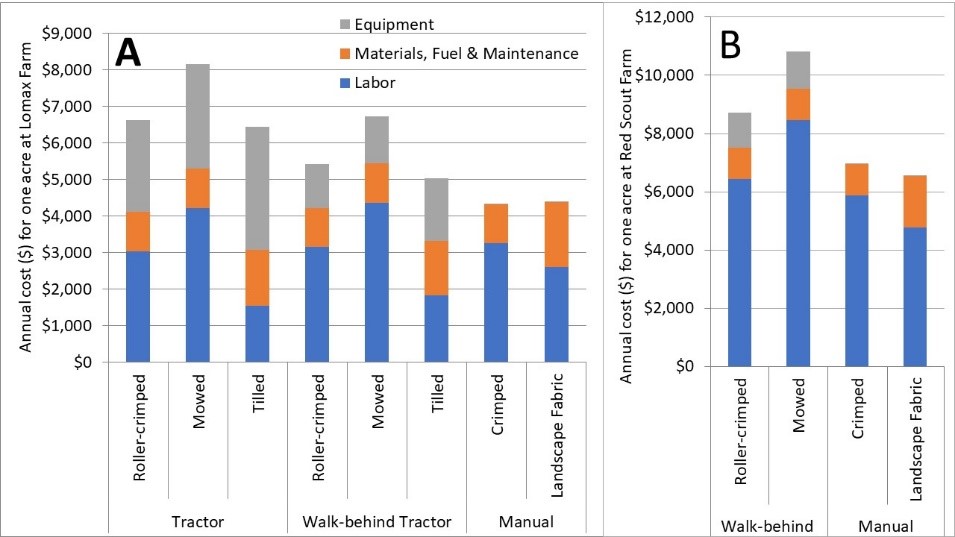by Mark Dempsey, CFSA Farm Services Manager | Wednesday, May 26, 2021 —
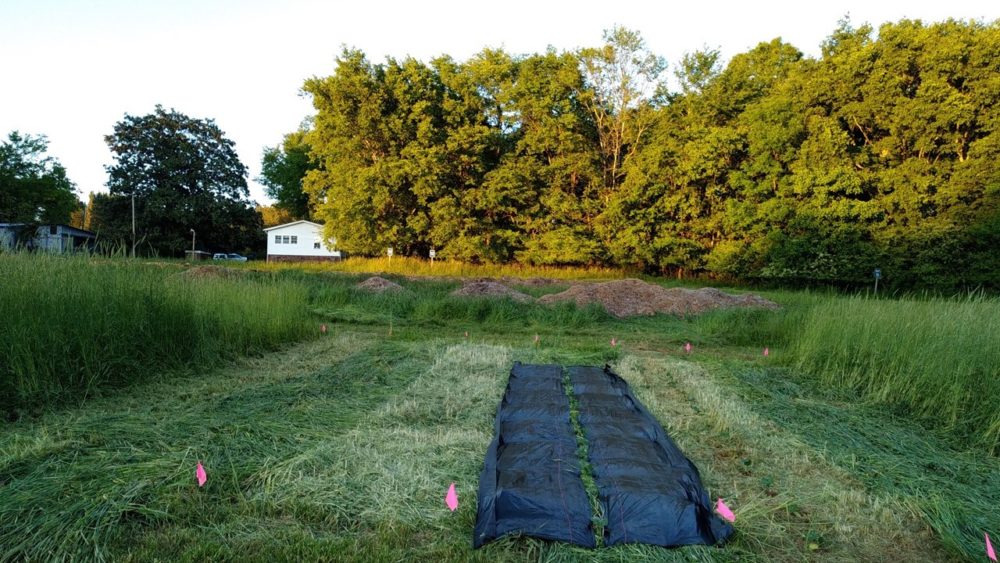
Research plots at Lomax Farm. Mowed and crimped plots, implemented using different equipment, straddle a plot covered with landscape fabric.
We’re excited to soon kick off the second year of CFSA’s organic, no-till research project at Lomax Farm, studying how well different cover crop-based, organic no-till systems perform, and the acreage at which each makes sense. If you’re a small- to mid-scale grower who wonders about which organic, no-till method or equipment to use, and whether it makes sense to invest in larger-scale equipment, it is our hope that this research will inform some of your decisions. While our research is not definitive – it covers only one crop and needs another year of data at least – it will hopefully provide a framework for navigating the decision-making process when taking on organic no-till or scaling up.
But, before getting into project results, let’s visit some of the questions that inspired this research. You may have asked yourself many of these questions already:
- What’s the best method to pull off a successful no-till crop: roller-crimper, flail mower, or something else?
- How do production costs and profits compare across different methods and acreages?
- At what acreage should I consider “buying up” and investing in a tractor or walk-behind tractor, and does cover crop termination method matter for acreage?
- How big can I go with different methods before I run out of time?
- How does all of this stack up against the organic industry standard: tilled and bedded with plastic mulch?
Method
To answer these questions, and two more (we’ll get to those), we set up an experiment based on killing a cover crop with a roller-crimper or flail mower using a tractor and walk-behind tractor, as well as tilling and bedding up with plastic mulch. Those treatments make up our “tractor-scale” and “walk-behind tractor-scale” (“walk-behind-scale” for short) treatments.
We also used a manual crimping method and landscape fabric. Again, the focus of the research was to better understand not only how crimping and mowing compare, but how each method scales up using a tractor, walk-behind tractor, or done manually.
And, finally, how does all of this compare to tilled with plastic mulch to understand if/where progress is needed in organic no-till systems. In 2019-2020 we implemented this in full at CFSA’s Elma C. Lomax Research and Education Farm (Concord, NC), and in part at Red Scout Farm (Black Mountain, NC), where only the no-till walk-behind-scale and manual treatments were implemented.
Only have a few minutes? Check out the high-level summary.
We used a single-species cover crop, cereal rye (Secale cereale), to keep things simple and predictable. If you’re new to all of this, cereal rye is the most popular and well-studied cover crop for organic no-till and should not be confused with ryegrass (Lolium multiflorum), which won’t easily die if crimped or mowed. Cereal rye was allowed to grow to the late flower/water ripe growth stage, or a little later to the late milk/early dough stage before termination (more on the different timings below). Rye was followed with butternut squash (variety: Atlas F1), which has a semi-vining habit, making it manageable from a data collection standpoint, but is also quick-to-canopy, making it suitable for organic no-till, which relies in part on the crop canopy for weed suppression.
The Main Takeaways
1. Don’t use a flail mower unless you follow it with added mulch (straw, landscape fabric, etc.). While flail mowers are shown off at organic no-till field days, and are tempting to use because termination and nutrient release are often better when mowed (compared to crimping), flail mowers should be avoided because the finely chopped cover crop mulch does not suppress weeds as well as a crimped cover crop.
If you already have a flail mower and want to put it to use, plan to follow it with landscape fabric or other persistent mulch.
Without added mulch, flail mowed cover crops result in a weedy mess with low yields or an expensive-to-produce crop on account of more labor invested in weeding, or both. You’ll see this reflected in the results throughout – weed pressure was consistently highest in mowed treatments – and therefore the labor invested in weeding was high in the mowed treatments, making mowing the most expensive treatments ($ spent/acre). In Figure 1 below, weeds are already established in the mowed plot just one month after planting, which would likely overtake the crop if allowed; in contrast, few to no weeds are growing in the crimped plot.
Figure 1. Plots at Red Scout Farm (four weeks after planting) showing abundant weeds (crabgrass) growing through the mowed rye mulch (right), but crimped rye mulch (left) is virtually weed-free.
2) We also wondered if smaller-scale crimping equipment, which is inherently lighter than a roller-crimper for a tractor, would kill the cover crop as well as the heavy, tractor-sized roller-crimper.
The short answer: Yes, we achieved equally successful rye termination across crimping equipment for the tractor, walk-behind tractor, and manually–despite the 2-fold range in down-pressure across equipment–by waiting until the late flower/water ripe stage (95-96% kill), and better kill at the late milk/early dough stage (99% kill). Rye that escapes termination can be problematic because it can compete with your summer crop or set seed, possibly becoming weedy in the next crop.
Crimper specs:
- Tractor-sized roller-crimper: made by I&J Manufacturing (Gordvonville, PA), weighs ~1200 lbs and is 5’ wide (240 lbs/ft).
- Roller-crimper for the walk-behind tractor: weighs 500 lbs, is 2.5’ wide (200 lbs/ft), can be disassembled into easy-to-handle components, and was fabricated for this project from mostly salvaged materials (Figure 2).
- Manual crimper: the one used in this project (Figure 3) consisted of a piece of 1.5” angle iron fastened to an 18” length of 2×6 lumber, which is attached to a rope held by the user. Because the manual crimper weighs only as much as its user, in this case it was 180 lbs (120 lbs/ft at 1.5’ wide) at Lomax Farm (less at Red Scout Farm, but still successful).
“If you’re crimping with smaller-scale equipment, it is recommended to wait until at least late flower to water ripe growth stages.”
Despite this result, it’s reasonable to expect that earlier termination (before late flower/water ripe) would require more down-pressure (lbs/ft) than is provided by smaller crimpers, and that the tractor-sized roller-crimper would perform best. Achieving more down-pressure with smaller-scale crimping equipment may not be possible, as the 500-lb roller-crimper for the walk-behind tractor is already difficult to handle, and the manual crimper would require either carrying weights or a very narrow crimper width (or both); thus, if you’re crimping with smaller-scale equipment, it is recommended to wait until at least late flower to water ripe growth stages. Finally, it’s worth noting that 200 lbs/ft is the recommended down-pressure for crimping, and that we were successful with the manual crimper (120 lbs/ft).
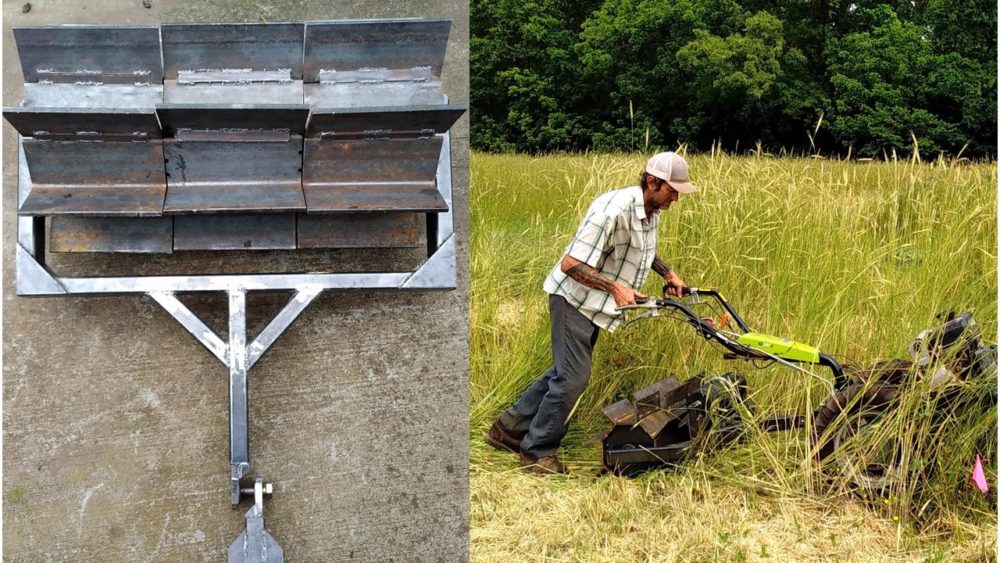
Figure 2. Roller-crimper for the walk-behind tractor. (Left)The roller-crimper is a lot to handle with a walk-behind tractor. For the 2021 season, the blades will be fixed in a staggered position to improve how it handles. (Right) Dylan Alexander, CFSA’s Lomax Farm Coordinator, operates the roller-crimper.
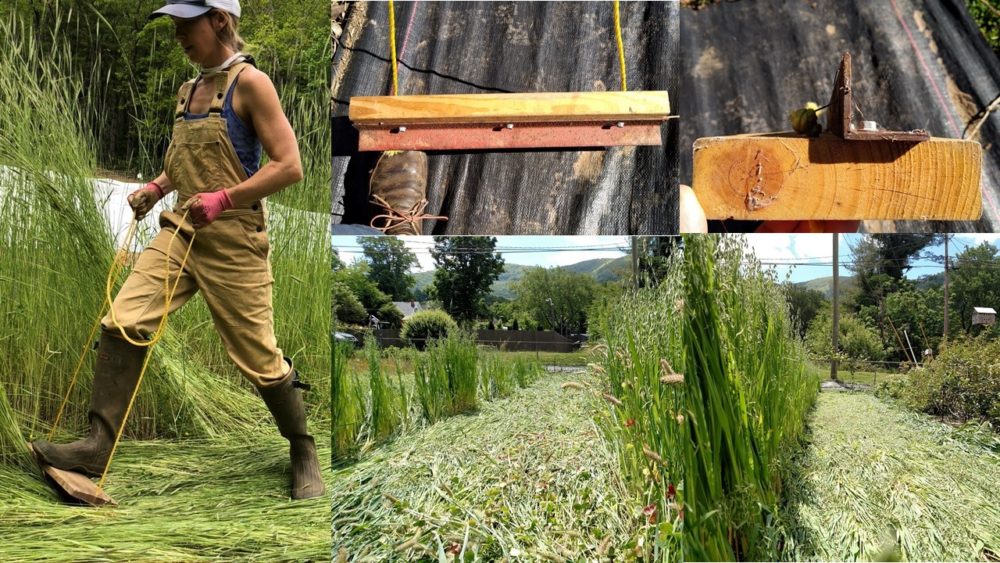
Figure 3. Manual crimper built for this project. (Left) Mary Carroll Dodd, Red Scout Farm, operates the manual crimper in the rye. (Right) Top: Its construction consists of 1.5” angle iron fastened to a 2×6, to which a rope is tied. Bottom: cover crops recently crimped with the manual crimper.
3) Weed pressure and the resulting time spent weeding should be a primary consideration when taking on cover crop-based no-till, as weed pressure (and therefore labor invested in weeding) drove the economics in our study.
In this experiment, weed control was performed manually for all treatments, owing to the lack of specialized cultivation equipment that keeps the cover crop mulch intact (i.e., a high-residue cultivator). If you look at Figure 4 (hours/acre), below, you’ll notice the gray part of each bar is time spent “weeding & spraying” (hours/acre) – the vast majority of which is weeding time – and is very high in mowing treatments (highest weed pressure), and very low in tilled and landscape fabric treatments (lowest weed pressure). This, in turn, led to very high labor costs, driven by time spent weeding, in crimped and mowed treatments, again, where weed pressure was higher (Figure 5). These results highlight the utility of landscape fabric on small-scale farms for saving labor invested in weeding, and also highlight the need for mechanized weed control (i.e., high-residue cultivation) for tractor- and walk-behind tractor-scaled farms.
Figure 4. Total management time (hours/acre) at Lomax Farm (A) and Red Scout Farm (B) broken down into six management categories. Note the difference in scale between Lomax and Red Scout Farms. Early- and late-crimped treatments are averaged to simplify data presentation.
Figure 5. Total annual production cost ($) for one acre of butternut squash at Lomax Farm (A) and Red Scout Farm (B) for each treatment, broken into three components. Note the difference in scale between Lomax and Red Scout Farms. Early- and late-crimped treatments are averaged to simplify data presentation.
4) Keep in mind that weed control was performed manually for all treatments, regardless of whether a tractor or walk-behind tractor was used to terminate cover crops or prepare beds, and if the appropriate weed control implement (a high-residue cultivator) were used with a tractor or walk-behind tractor, the cost of production would decrease substantially, especially as treatments scale-up in acreage.
This is simply because field operations are completed more efficiently when mechanized, and the economies of scale achieved with mechanization are eroded by the need for manual weed control. Thus, we expect that if better weeding efficiency were achieved (hours/acre) in tractor and walk-behind tractor treatments, then these treatments may outperform ($ spent/acre) manual methods at smaller acreages (perhaps <5 acres).
“Field operations are completed more efficiently when mechanized, and the economies of scale achieved with mechanization are eroded by the need for manual weed control.”
5) When considering how the total cost of production scales up with acreage, there are two things to note:
- Above three acres, the cover crop termination method was more important than the equipment used (Figure 6A). Driven by time spent weeding, mowing was the most expensive while tilling was the least expensive.
- At less than approximately one acre, equipment was more important to total costs than termination methods (Figure 6B), due to the upfront costs of equipment and the fact that these costs are not spread across large acreage. This result is surprising; one would expect that economies of scale resulting from using a (walk-behind) tractor would be quickly achieved as acreage increased. However, this was not the case in this study, likely because weed control was performed manually in all treatments.
If you follow the lines on Figure 6 (below) up in acreage, you’ll see that:
- Tilled treatments (solid golden lines) were quick to “overtake” no-till treatments (i.e., become cheaper), and were cheapest overall starting between 1.6 and 2.7 acres.
- When considering only the no-till treatments, both mowed treatments (dotted blue lines) were most expensive by 0.9 acres, reiterating that mowing should be avoided regardless of scale, unless followed with a persistent mulch.
- The crimped treatments (dashed green lines) were considerably less expensive to implement than mowing as acreage increased; if you follow crimped treatment lines up in acreage, you’ll see that they converge (and thus were comparable) near 10 acres.
- On fewer than 1.6 acres, manual methods were the cheapest overall to implement and were also the cheapest no-till methods up to at least five acres, likely more (but see #4, above, about weed control). The landscape fabric treatment was cheaper to implement than mechanized crimped treatments up to 7.5 to 9.5 acres.
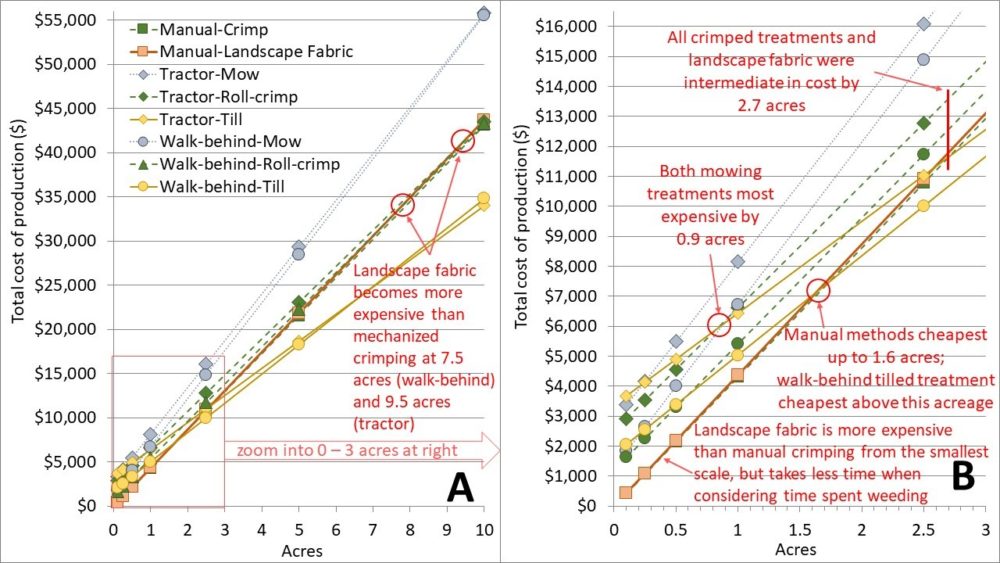
Figure 6. Total cost of production by acreage for all treatments, scaled from 0-10 acres. (A) Illustrates that method determines cost more than equipment above three acres. (B) Illustrates that equipment determines cost more than method at fewer than three acres.
Red text highlights main takeaways and may help with interpretation. Note that the slope (angle) of each line is sensitive to time spent weeding and would likely decrease considerably with more efficient weed control (high-residue cultivation) in tractor and walk-behind tractor treatments, changing the acreage at which one equipment/method costs more or less to implement.
6) Yields and Profitability:
At Lomax Farm
Unfortunately, it was a rough year for no-till production at Lomax, essentially resulting in a crop failure. We were unable to compare yields across treatments. This was mostly from pest pressure: ryegrass (Lolium species) and brome (Bromus species) early in the season, followed by large crabgrass (Digitaria sanguinalis) later in the season in tandem with intense pressure from squash bugs (Anasa tristis). The crop also experienced early-season nitrogen limitation, giving the weeds a leg-up from the beginning. From the sparse yield data collected at Lomax, which could not be tested statistically, there was a trend of higher yields in tilled treatments and lower yields in mowed and early-crimped treatments. Landscape fabric and late-crimped treatments were intermediate.
At Red Scout Farm
In contrast, yields were good (averaging 27,280 lbs/acre among treatments; 6.25 lbs/plant; 1.4 fruits/plant). Because treatments were not replicated at Red Scout, it’s too soon to say whether there were differences among treatments. That said, it’s not surprising that yield in the landscape fabric treatment was highest (8.75 lbs/plant), and yields were lower in the crimped and mowed treatments (5.75 and 5.83 lbs/plant, respectively), likely owing to quicker nutrient release from the cover crop and lower weed pressure in the landscape fabric treatment.
Yields were comparable between crimped and mowed treatments despite higher weed pressure in mowed treatments likely because weeds were controlled before they could compete with the crop.
Again, we need more data (replication and another year) before comparing yields across treatments, but a quick look at average values suggest tilled and landscape fabric treatments may have the highest yields, and mowed treatments may have the lowest yields (owing to differences in nutrient availability and weed pressure). An acreage-scaled cost-profit analysis was not performed because yield data were not replicated, but yield and production cost data from Red Scout Farm suggest that yields in all treatments were higher than breakeven yields (with squash valued down to $0.50/lb), with the largest margin in the landscape fabric treatment.
7) When considering how big you can go before running out of time, if you assume a 40-hour week for a five-month period, then you have about 850 hours to work with. While it’s unlikely butternut squash would be the sole crop grown on a farm in any year, the lack of acreage-scaled labor hours data for other crops limits our analysis to butternut squash.
From this analysis, we determined that:
- The maximum acreage achievable among no-till treatments was highest for the landscape fabric treatment (3.8 acres), followed by crimped treatments (3.2±0.2 acres; highest for tractor and lowest for manual), followed by mowing treatments (2.4±0.1 acres; highest for tractor and lowest for manual).
- The maximum farmable acreage in the tilling treatments was highest (5.6 acres, walk-behind tractor; 6.6 acres, tractor).
Similar to total cost and per-acre cost results, if suitable weed control equipment were used in tractor and walk-behind tractor treatments, then the maximum farmable acreage could increase substantially.
8) Tilled treatments outperformed no-till treatments by most metrics (production costs, scalability, weed pressure, etc.), highlighting the need for improvements in cover crop-based organic no-till production, especially weed control.
As discussed above, weed pressure drove the cost of labor, which in turn was a large component of total production costs. When combined with the fact that the application of plastic mulch is mechanized, the low investment in weed control in tilled treatments translates to cheaper implementation compared to their no-till counterparts, especially as acreage increases and economies of scale are achieved. Further, while it’s too soon to say whether tilled treatments yield higher than no-till ones, it is reasonable to expect that they may have higher yields based on quicker nutrient release from decomposing cover crops (incorporated into soil vs. left on surface), lower weed pressure, and the limited yield data we were able to collect.
From this, we see two important yet divergent ways to improve cover crop-based no-till production:
- When using a tractor or walk-behind tractor, the use of a high-residue cultivator has the potential to decrease investment in time spent weeding and improve crop yields. This is low-hanging fruit for tractor-scaled production, given that this equipment already exists for a reasonable price. While such equipment does not exist for walk-behind tractors in ready-to-buy form, it can be adapted and fabricated from existing cultivation equipment designed for walk-behind tractors.
- In roller-crimped and mowed no-till systems, weed control from high-residue cultivation is not as complete, and nutrient release from cover crops is slow compared to tillage-based systems and ones that use landscape fabric.
Because of this, we’re going out on a limb to suggest that roller-crimped and mowed systems will never perform as well as tilled ones (even with better weed control), and to advocate for the development of a new technology to mechanize the application of landscape fabric or similar material (not using soil as an anchor) to provide season-long weed suppression and improve nutrient supply to crops from more rapid decomposition of cover crop mulches.
Technology such as this, if affordable like many plastic mulch layers, could bring successful organic no-till vegetable production within reach for many more farmers, and have similar yield and economic benefits that plastic mulch had several decades ago, as well as significant benefits to soil health and on-farm conservation.
High-Level Summary of Research Results
- Don’t use a flail mower unless you follow it with a persistent mulch, like landscape fabric.
- We achieved successful rye termination across crimping equipment for the tractor, walk-behind tractor, and manually by waiting until the late flower/water ripe stage.
- Weed control was performed manually across all treatments; using a high-residue cultivator for a tractor or walk-behind tractor has the potential to substantially decrease production costs.
- One acre or less, the equipment used (tractor vs. walk-behind tractor vs. manual) determined production cost more than cover crop termination method (crimping, mowing, etc.); the opposite is true above three acres.
- Tilled treatments outperformed no-till treatments, highlighting the need for mechanizing weed control to reduce time spent weeding and improve yields in no-till, and possibly mechanizing the application of landscape fabric, which may be our best bet for parity between tilled and organic no-till systems.
Questions? Want More?
- Read the full report on Southern Sustainable Agriculture Research and Education (SARE)’s website.
- Bit by the research bug? Check out CFSA’s Organic Research section.
- Have questions? Want to participate in future no-till research? Email the article author, Mark Dempsey, at mark@carolinafarmstewards.org.
Support for this project was provided by Southern Sustainable Agriculture Research and Education (SARE) grant OS 19-129 for the 2020 growing season and by Organic Valley’s Farmers Advocating for Organics (FAFO) for the 2021 growing season.



